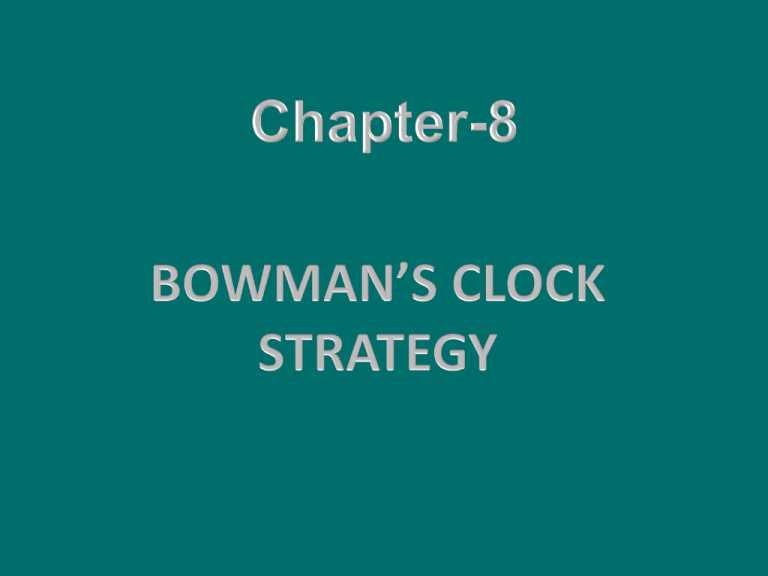Bowman's Strategy Clock
advertisement

Definition - What does Bowman's Strategy Clock mean? • Bowman’s strategy clock is a diagrammatic representation of the relationship between customer value and prices. • Cliff Bowman created the visualization in 1996 based on Michael Porter’s three strategic classic strategies. • As with Porter's Generic Strategies, Bowman considers competitive advantage in relation to cost advantage or differentiation advantage. • Bowman's Strategy Clock represents eight possible strategies in four quadrants defined by the axes of price and perceived added value. • The resulting star shape is indicative of a clock face, giving this tool its name Position 1: Low Price - Low Value • A low price – low value positioning -is offering poor quality products at the lowest price in the market. • Many companies adopt such a strategy when their products come under pressure from the competitors low prices, and they cannot overcome such price wars by offering products that differ in some way. • Companies adopting this strategy would require high sales volumes to compensate for the low prices, and by extension low margins. • The low price would fetch such volumes, but the low quality would mean that most customers would try the product only once. • As such, this strategy suits only products with a short life cycle, where repeat customers are not relevant, or on products where quality is not an issue Position 2: Low Price • Companies competing in this category are the low cost leaders. • These are the companies that drive prices down to bare minimums, and they balance very low margins with very high volume. • If low cost leaders have large enough volume or strong strategic reasons for their position, they can sustain this approach and become a powerful force in the market. • If they don't, they can trigger price wars that only benefit consumers, as the prices are unsustainable over anything but the shortest of terms. • Walmart is a key example of a low price competitor that persuades suppliers to enter the low price arena with the promise of extremely high volumes First two options are about the low price. First option is totally low cost low added value but the second option totally about to be a “cost leader” without caring its value. Second option has the risk of price war and low margin. Position 3: Hybrid (moderate price/moderate differentiation) • Hybrids are interesting companies. • They offer products at a low cost, but offer products with a higher perceived value than those of other low cost competitors. • Volume is an issue here but these companies build a reputation of offering fair prices for reasonable goods. • Good examples of companies that pursue this strategy are discount department stores. • The quality and value is good and the consumer is assured of reasonable prices. • This combination builds customer loyalty. Position 4: Differentiation • Companies that differentiate offer their customers high perceived-value. • To be able to afford to do this they either increase their price and sustain themselves through higher margins, or they keep their prices low and seek greater market share. • Branding is important with differentiation strategies as it allows a company to become synonymous with quality as well as a price point. • Nike is known for high quality and premium prices; Reebok is also a strong brand but it provides high value with a lower premium. Position 5: Focused Differentiation • These are your designer products: High perceived value and high prices. • Consumers will buy in this category based on perceived value alone. • The product does not necessarily have to have any more real value, but the perception of value is enough to charge very large premiums. • Think Gucci, Armani, Rolls Royce. clothes either cover you or they don't, and a car either gets you around the block or it doesn't. • If you believe pulling up in your Rolls Royce Silver Shadow is worth 25 times more than in an economy Ford then you will pay the premium. • Highly targeted markets and high margins are the ways these companies survive Position 6: Increased Price/Standard Product • Sometimes companies take a gamble and simply increase their prices without any increase to the value side of the equation. • When the price increase is accepted, they enjoy higher profitability. • When it isn't, their share of the market plummets, until they make an adjustment to their price or value. • This strategy may work in the short term, but it is not a long-term proposition as an unjustified price premium will soon be discovered in a competitive market. Position 7: High Price/Low Value • This is classic monopoly pricing, in a market where only one company offers the goods or service. • As a monopolist, you don't have to be concerned about adding value because, if customers need what you offer, they will pay the price you set, period. • Fortunately for consumers in a market economy, monopolies do not last very long, if they ever get started, and companies are forced to compete on a more level playing field Position 8: Low Value/Standard Price • Any company that pursues this type of strategy will lose market share. • If you have a low value product, the only way you will sell it is on price. • You can't sell day-old bread at fresh prices • Mark it down a few cents, and suddenly you have a viable product. That is the nature of consumer behavior, and you will not get around it, no matter how hard you try. • • • Positions 6, 7, and 8 are not viable competitive strategies in truly competitive marketplaces. Whenever price is greater than perceived value you have an uphill battle on your hands. There will always be competitors offering better quality products at lower prices so you have to have your value and price aligned correctly. When considering which competitive strategy to pursue, here are some questions you should ask yourself. If you intend to compete on price: • Are you a price leader? • Can you sustain a cost leader position? Can you control your costs and sustain a good margin? • Are you able to exploit all of the cost advantages available to you? • Can you balance low price against the perception of too low value? • Is your cost advantage limited to one or a few small market segments? Are these segments capable of sustaining your business, given the volume and margins you project? If you intend to compete on perceived value: • • • • Do you have a well-identified target market? Do you understand what your target market truly values? Are you aware of the perceived value of your competitor's products? Are there areas of differentiation that you can capitalize on that others cannot easily copy? • Do you have alternate methods of differentiation in the event you lose your competitive advantage in that area? • Bowman's Strategy Clock is a very useful model to help you understand how companies compete in the marketplace. • By looking at the different combinations of price and perceived value, you can begin to choose a position of competitive advantage that makes sense for you and your organization's competencies. • This is a powerful way of looking at how to establish and sustain a competitive position in a market driven economy. • By understanding these eight basic strategic positions, you can analyze and evaluate your current strategy and determine if adjustments might improve your overall competitive position (c) Bowman’s Strategy Clock • • • • • • • • The high level competition needs efficient strategy to gain advantages and at the same time high profit. In different times we can put Ryanair’s strategy in different options in Bowman’s Strategy Clock. But all of them can be placed between options 1 to 5. Their strategy never placed in failure part of Bowman’s clock. Mainly, in these days Ryanair place in the clock is between options 1-2, which is mainly about low price. We can easily realize Ryanair is the best example for this option. If they can secure their price and gives higher valued service they can easily take a place option three and they will be strongest company in the competition. In my opinion, hybrid strategy is the most preferable strategy in the clock that is why Virgin Airlines prefer this option. If Ryanair updates their lowest price strategy with a standard service they easily will be the strongest company in the competition.




